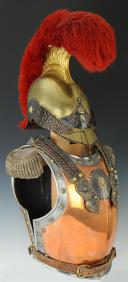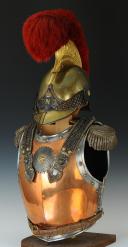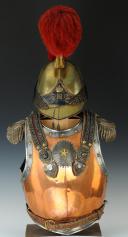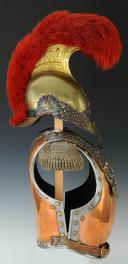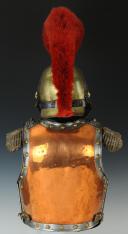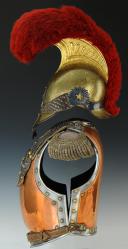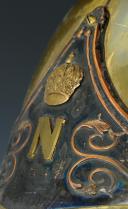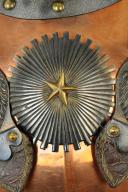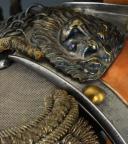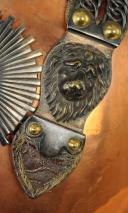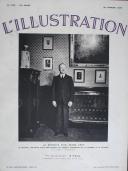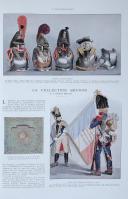
CASQUE ET CUIRASSE D'OFFICIER DE CARABINIERS, MODÈLE 1810, PREMIER EMPIRE.
Sold out
OFFICER HELMET AND BREASTPLATE OF CARABINIERS, MODEL 1810, FIRST EMPIRE.
From the former collection of Raoul and Jean Brunon.
HELMET
The helmet presented by Jean Brunon in the technical sheets published in the magazine Uniformes, under the reference FCa2, is described as follows:
"Napoleon decided to equip the two carabinier regiments with armor, with the helmet and breastplate models being richer than those of the cuirassiers. During the 1809 campaign, they served with the Emperor and the Imperial Guard before his return from Spain. At Landshut, Eckmühl, and Ratisbon, Napoleon noticed the inefficiency of bearskin caps against saber blows. After Wagram, his decision made, the Emperor signed the decree for the armor's allocation on December 24, 1809, despite the reluctance of the two regiments who saw it as a critique of their conduct, which had always been exemplary, especially as they regretted the replacement of their dark blue uniform with a white one at the same time.
The officer's helmet, always more ornate, had a gilded copper dome (or non-gilded red), the headband, chin scales, and rosettes in silvered copper, as well as the trimmings of the visor and neck guard. The crowned 'N' was smaller than that of the troop (the 'N' of the Second Empire, larger and striated, was sometimes added to some helmets where the original 'N' had been removed in 1814). The narrow cimier was richly decorated in gilded copper. Chin scale cords in silver thread. These helmets are even rarer as they were worn for less than 4 years.”
The helmet is entirely made of gilded brass, except for the two headbands, chin scales, and visor and neck guard trims, which are silvered copper. The dome is of the minerva shape, quite tall and tilted towards the back, measuring 14 cm in height. It is composed of two half-shells welded together at the top, with the junction covered by a 5 mm wide brass strip.
The visor tapers to a point in the center, 6 cm wide, bordered by a folded silvered copper strip on the outer edge (7 mm wide). The visor is lined with green waxed morocco leather.
The neck guard is similarly encircled like the visor, with a strip attached by 2 silvered copper nails (6 mm wide).
The front headband is silvered copper, bordered at the top by a double raised molding with a striated center (8.5 mm wide), ending in a droplet shape at its center. It is topped with a palmette, with a gilded brass screw placed to secure the headband. The bottom part of the headband does not have a molding and forms a point at the center. Side height of the headband is 2.5 cm, center height is 11 cm. Each side of the headband is embossed with fine volutes, a distinct feature of authentic helmets (on replicas, the designs are different or coarser). In the center, an "N" is riveted (2.1 cm in height, 1.9 cm in width), topped with an imperial crown (2.7 cm in height, 2.7 cm in width).
The rear headband is also silvered copper, with a double raised molding at the top. Side height is 2.7 cm, center height is 3.7 cm.
The cimier consists of two side fins and a brass mask. Each fin features a curvilinear triangle, with a festooned edge connecting to the dome, decorated with small gadroons. The fins are embossed with an acanthus leaf frame and laurel branches intertwined with ribbons in the middle, followed by nine gadroons decreasing towards the back, separated by water leaves on a grainy background. Each fin is attached to the dome with four gilded brass screws. Maximum height of the fins is 14 cm. The mask is welded to the two fins, bordered by a raised molding and a striped ribbon (2.2 cm wide at the top, 2 cm wide at the center); its base is flared, framed by palm leaves (3.8 cm wide). Originally, the cimier extends to the top of the headband where it is fixed underneath. At the top of the cimier, a winged screw secures the plume, as does the right fin.
The plume is made of scarlet horsehair mounted on an iron pole (6 cm in diameter at the rear, 15 cm in diameter at the front); it extends about 10 cm from the cimier.
The chin scales consist of a leather chin strap covered in black velvet, finished with silver trim cords, overlaid with a series of 17 silvered copper scales alternately cut into four and three scallops; the penultimate scale is cut in two and the last in one. Apparent length of the chin straps is 14 cm, maximum width is 5.7 cm, minimum width is 1.7 cm. The rosette, cut and embossed in relief from silvered copper, depicts a radiant sun (6.7 cm in height, 8 cm in width); a 2.6 cm diameter brass star is mounted in the center.
Interior lining in sheepskin cut into seven lappets.
In very good condition, partial loss of gilding on the dome, visor, and neck guard; silver plating on the headband showing wear on the reliefs; visor and neck guard trims showing wear on their ends; split in the left side of the visor trim; cimier retaining its gilding; base of the mask missing; interior lining worn with missing and torn parts.
BREASTPLATE
Information about the troop breastplate for the Carabiniers is from a text dated June 1811 found in the artillery archives:
"CARABINIERS. The front pieces (plastrons) are made of coriandered German sheet metal laminated in Sedan. Each sheet is 36 inches (97.5 cm) in length, 18 inches (48.7 cm) in width, and 10 to 11 points thick (0.19 to 0.21 cm) reducing to 9 to 10 points (0.17 to 0.19 cm). One sheet yields two fronts and weighs 15 to 15 1/2 pounds (7.33 to 7.58 kg).”
“The backs (dossières) are made of iron sheet metal. The sheet for these backs is 36 inches (97.5 cm) in length, 18 inches (48.7 cm) in width, and 9 to 10 points thick (0.17 to 0.19 cm) reducing to 8 and 9 points (0.15 to 0.17 cm). One sheet yields two backs and weighs 14 to 15 pounds (6.84 to 7.33 kg).”
“The yellow copper sheets that are applied to the breastplates come from Stolbert or Namur. Each sheet is 46 inches (124.5 cm) in length and 4 points (0.07 cm) thick, weighing 7 1/2 to 8 pounds (3.67 to 4.11 kg); one sheet produces three pieces, either for the fronts or backs. Width is 16 inches (47.8 cm).”
"Here are the technical manufacturing conditions, tinning, and soldering. It will suffice to indicate that the copper sheet is fixed to the tin sheet with a small copper rivet placed at each corner, four on the plastron and four on the dossière.”
"The shoulder pads are made the same as those of cuirassiers, except that they are lined with black sheepskin instead of cloth and each is covered with two flat copper chains, instead of scales. The straps are made of black cowhide. All carabinier breastplates are of the largest size. The completed breastplate weighs 15 1/2 to 16 pounds (7.58 to 7.82 kg).”
Adding to this troop model description, here are the unique elements specific to the officer's breastplate:
The brass sheets are either gilded or, as in this case, in a copper alloy called "red copper." Each is plated onto the steel part using four domed brass rivets.
A round ornament in silvered metal, representing a radiant sun with a 5-point brass star at its center (diameter 2.9 cm), is attached to the upper part of the front plate (between the shoulder pads). On this particular example, the sun is made of silver (height 10.8 cm, width 10.5 cm; this difference is because the sun is slightly domed to fit the breastplate's shape).
The front plate tapers to a point with a slight boss (rounded for the troops).
A 2.3 cm wide band, not covered in copper, frames the perimeter of the front plate and back plate, adorned with 34 domed brass rivets on each part.
At the bottom, a leather belt (2.8 cm in height) covered in red waxed morocco leather (now turned brown) and embroidered at the top and bottom with a silver trim strip is attached to the back plate on each side by two brass screws, securing the front plate to the back plate. This belt fastens with an oval-shaped brass buckle (4.1 cm in height, 4.6 cm in width). Both parts of the breastplate are bordered by a 9 mm wide steel padding strip. Two studs are placed at the front of the plastron for attaching the shoulder pads.
The shoulder pads are leather covered with red cloth (5 cm wide) and bordered on each side by a silver galloon (1 cm wide). At the top, a silvered metal tab secures the shoulder pad to the back plate with three large flat screws. This tab is covered with a lion's head in embossed silvered brass (6 cm in height, 5.4 cm in width). The leather part is covered with a double chain made of silvered metal rings interlocked (ring diameter 1.6 cm). The shoulder pads end at the bottom with decorations in embossed silvered metal with scalloped ends and featuring a lion's head in relief (total height of the decorations 11.3 cm, lion's head height 6.3 cm, maximum width 5.3 cm). At the top, these decorations are fastened to the shoulder pad with two domed brass rivets (diameter 1.3 cm), and at the bottom by two smaller domed brass rivets, 9 mm in diameter, securing a heart-shaped tab (5.8 cm in height, 5.3 cm in width) made of leather covered in red waxed morocco leather, edged with an embroidered silver trim strip.
In very good condition, signs of wear and leather replacement on a 9.5 cm length at the belt.
EPAULETTES
A pair of colonel's epaulettes in silver passementerie, woven in a herringbone pattern, with turning fringe and large seed-like ornaments called "spinach," lined with dark blue cloth.
In good condition.
France.
First Empire.
NOTE:
Helmet: Carabinier helmets from the First Empire are rare. While some troop examples still exist, officer models are almost impossible to find. They were all modified in 1814 and then, during the Second Restoration, they were altered for use by Monsieur's Carabiniers. The Raoul and Jean Brunon collection owned three First Empire Carabinier officer helmets:
- the presented example, the most exceptional, is preserved in its original state with intact "N" and crown,
- one example sold in 1966 to the Army Museum, modified in 1814 and further during the Hundred Days with the "N" and crown replaced by a gilded brass flaming bomb,
- one example modified in 1815-1816 for Monsieur's Carabiniers with an "N" and crown replaced by a brass motif with Monsieur's Arms.
There is a privately held silver headband with original imperial monograms, and the Army Museum also houses an officer's helmet.
Breastplate: there are two types of officer breastplates. One is quite luxurious with gilded brass plates framed with raised lines and more elaborate three-chain shoulder pads, with a lion's head of different design and intricately decorated locks embossed with oak and laurel leaves. The other is a more rugged model, likely for combat, with copper plates and two-chain shoulder pads and less elaborate locks, similar to the cuirass officer shoulder pads at the end of the Empire. This second type of breastplate was likely used towards the very end of the Empire and is often depicted in contemporaneous iconography, remaining the rarest of the two types. The former Brunon collection example is one of the few, if not the only known, surviving examples.
PROVENANCE:
This set of helmet and breastplate comes from the former collection of Raoul and Jean Brunon, purchased between 1919 and 1938 by Jean Brunon, a renowned collector.
On January 26, 1935, in issue number 4795 of the famous magazine L'ILLUSTRATION, General Brécard dedicated a four-page color article to "La collection Brunon." Five sets and breastplates from the First Empire and the Ancient Monarchy, including an officer ensemble of First Empire Carabiniers with the helmet presented here (the breastplate is the luxury model sold to the Army Museum in 1966), are shown in title photos.
In 1966, this helmet was inventoried by Jean Brunon in the document "Chiffre inventory of the collection 'History through objects of the French armies since 1700' from the Archives and Collections Raoul and Jean Brunon," on page 65: "Helmet and breastplate of officer Carabiniers, First Empire. Very fine set, extremely rare."
"Helmet and breastplate, ditto, 1815." This second set was sold to the Army Museum in 1967, and referenced on page 2. It is the example where the helmet was modified in 1815 with a grenade on the headband; it is currently displayed on a mannequin at the Château de l'Empéri in Salon-de-Provence.
In 1967, during the sale of the collection to the Army Museum, Mr. Brunon retained a selection of items including this set, as mentioned on page 2.
Following the death of Mr. Jean Brunon in 1983, his collection was divided among his three children: Anne, Paul, and Raoul (who was a curator at the time at the Musée de l'Empéri). It was Paul Brunon who inherited the officer ensemble of First Empire Carabiniers, which he sold to the Parisian antiquarian Charles Marchal in February 1983 (helmets and officer breastplates of First Empire Cuirassiers, officer helmet of First Empire Dragoons, officer helmet of Dragoon Guards model 1804). A document certified by Raoul Brunon attests to this fact.
That same year, Mr. Guy Kaufmann purchased the officer ensemble of Cuirassiers, the officer helmet of Line Dragoons, and the officer ensemble of Carabiniers from the former Brunon collection from Charles Marchal.
From the former collection of Raoul and Jean Brunon.
HELMET
The helmet presented by Jean Brunon in the technical sheets published in the magazine Uniformes, under the reference FCa2, is described as follows:
"Napoleon decided to equip the two carabinier regiments with armor, with the helmet and breastplate models being richer than those of the cuirassiers. During the 1809 campaign, they served with the Emperor and the Imperial Guard before his return from Spain. At Landshut, Eckmühl, and Ratisbon, Napoleon noticed the inefficiency of bearskin caps against saber blows. After Wagram, his decision made, the Emperor signed the decree for the armor's allocation on December 24, 1809, despite the reluctance of the two regiments who saw it as a critique of their conduct, which had always been exemplary, especially as they regretted the replacement of their dark blue uniform with a white one at the same time.
The officer's helmet, always more ornate, had a gilded copper dome (or non-gilded red), the headband, chin scales, and rosettes in silvered copper, as well as the trimmings of the visor and neck guard. The crowned 'N' was smaller than that of the troop (the 'N' of the Second Empire, larger and striated, was sometimes added to some helmets where the original 'N' had been removed in 1814). The narrow cimier was richly decorated in gilded copper. Chin scale cords in silver thread. These helmets are even rarer as they were worn for less than 4 years.”
The helmet is entirely made of gilded brass, except for the two headbands, chin scales, and visor and neck guard trims, which are silvered copper. The dome is of the minerva shape, quite tall and tilted towards the back, measuring 14 cm in height. It is composed of two half-shells welded together at the top, with the junction covered by a 5 mm wide brass strip.
The visor tapers to a point in the center, 6 cm wide, bordered by a folded silvered copper strip on the outer edge (7 mm wide). The visor is lined with green waxed morocco leather.
The neck guard is similarly encircled like the visor, with a strip attached by 2 silvered copper nails (6 mm wide).
The front headband is silvered copper, bordered at the top by a double raised molding with a striated center (8.5 mm wide), ending in a droplet shape at its center. It is topped with a palmette, with a gilded brass screw placed to secure the headband. The bottom part of the headband does not have a molding and forms a point at the center. Side height of the headband is 2.5 cm, center height is 11 cm. Each side of the headband is embossed with fine volutes, a distinct feature of authentic helmets (on replicas, the designs are different or coarser). In the center, an "N" is riveted (2.1 cm in height, 1.9 cm in width), topped with an imperial crown (2.7 cm in height, 2.7 cm in width).
The rear headband is also silvered copper, with a double raised molding at the top. Side height is 2.7 cm, center height is 3.7 cm.
The cimier consists of two side fins and a brass mask. Each fin features a curvilinear triangle, with a festooned edge connecting to the dome, decorated with small gadroons. The fins are embossed with an acanthus leaf frame and laurel branches intertwined with ribbons in the middle, followed by nine gadroons decreasing towards the back, separated by water leaves on a grainy background. Each fin is attached to the dome with four gilded brass screws. Maximum height of the fins is 14 cm. The mask is welded to the two fins, bordered by a raised molding and a striped ribbon (2.2 cm wide at the top, 2 cm wide at the center); its base is flared, framed by palm leaves (3.8 cm wide). Originally, the cimier extends to the top of the headband where it is fixed underneath. At the top of the cimier, a winged screw secures the plume, as does the right fin.
The plume is made of scarlet horsehair mounted on an iron pole (6 cm in diameter at the rear, 15 cm in diameter at the front); it extends about 10 cm from the cimier.
The chin scales consist of a leather chin strap covered in black velvet, finished with silver trim cords, overlaid with a series of 17 silvered copper scales alternately cut into four and three scallops; the penultimate scale is cut in two and the last in one. Apparent length of the chin straps is 14 cm, maximum width is 5.7 cm, minimum width is 1.7 cm. The rosette, cut and embossed in relief from silvered copper, depicts a radiant sun (6.7 cm in height, 8 cm in width); a 2.6 cm diameter brass star is mounted in the center.
Interior lining in sheepskin cut into seven lappets.
In very good condition, partial loss of gilding on the dome, visor, and neck guard; silver plating on the headband showing wear on the reliefs; visor and neck guard trims showing wear on their ends; split in the left side of the visor trim; cimier retaining its gilding; base of the mask missing; interior lining worn with missing and torn parts.
BREASTPLATE
Information about the troop breastplate for the Carabiniers is from a text dated June 1811 found in the artillery archives:
"CARABINIERS. The front pieces (plastrons) are made of coriandered German sheet metal laminated in Sedan. Each sheet is 36 inches (97.5 cm) in length, 18 inches (48.7 cm) in width, and 10 to 11 points thick (0.19 to 0.21 cm) reducing to 9 to 10 points (0.17 to 0.19 cm). One sheet yields two fronts and weighs 15 to 15 1/2 pounds (7.33 to 7.58 kg).”
“The backs (dossières) are made of iron sheet metal. The sheet for these backs is 36 inches (97.5 cm) in length, 18 inches (48.7 cm) in width, and 9 to 10 points thick (0.17 to 0.19 cm) reducing to 8 and 9 points (0.15 to 0.17 cm). One sheet yields two backs and weighs 14 to 15 pounds (6.84 to 7.33 kg).”
“The yellow copper sheets that are applied to the breastplates come from Stolbert or Namur. Each sheet is 46 inches (124.5 cm) in length and 4 points (0.07 cm) thick, weighing 7 1/2 to 8 pounds (3.67 to 4.11 kg); one sheet produces three pieces, either for the fronts or backs. Width is 16 inches (47.8 cm).”
"Here are the technical manufacturing conditions, tinning, and soldering. It will suffice to indicate that the copper sheet is fixed to the tin sheet with a small copper rivet placed at each corner, four on the plastron and four on the dossière.”
"The shoulder pads are made the same as those of cuirassiers, except that they are lined with black sheepskin instead of cloth and each is covered with two flat copper chains, instead of scales. The straps are made of black cowhide. All carabinier breastplates are of the largest size. The completed breastplate weighs 15 1/2 to 16 pounds (7.58 to 7.82 kg).”
Adding to this troop model description, here are the unique elements specific to the officer's breastplate:
The brass sheets are either gilded or, as in this case, in a copper alloy called "red copper." Each is plated onto the steel part using four domed brass rivets.
A round ornament in silvered metal, representing a radiant sun with a 5-point brass star at its center (diameter 2.9 cm), is attached to the upper part of the front plate (between the shoulder pads). On this particular example, the sun is made of silver (height 10.8 cm, width 10.5 cm; this difference is because the sun is slightly domed to fit the breastplate's shape).
The front plate tapers to a point with a slight boss (rounded for the troops).
A 2.3 cm wide band, not covered in copper, frames the perimeter of the front plate and back plate, adorned with 34 domed brass rivets on each part.
At the bottom, a leather belt (2.8 cm in height) covered in red waxed morocco leather (now turned brown) and embroidered at the top and bottom with a silver trim strip is attached to the back plate on each side by two brass screws, securing the front plate to the back plate. This belt fastens with an oval-shaped brass buckle (4.1 cm in height, 4.6 cm in width). Both parts of the breastplate are bordered by a 9 mm wide steel padding strip. Two studs are placed at the front of the plastron for attaching the shoulder pads.
The shoulder pads are leather covered with red cloth (5 cm wide) and bordered on each side by a silver galloon (1 cm wide). At the top, a silvered metal tab secures the shoulder pad to the back plate with three large flat screws. This tab is covered with a lion's head in embossed silvered brass (6 cm in height, 5.4 cm in width). The leather part is covered with a double chain made of silvered metal rings interlocked (ring diameter 1.6 cm). The shoulder pads end at the bottom with decorations in embossed silvered metal with scalloped ends and featuring a lion's head in relief (total height of the decorations 11.3 cm, lion's head height 6.3 cm, maximum width 5.3 cm). At the top, these decorations are fastened to the shoulder pad with two domed brass rivets (diameter 1.3 cm), and at the bottom by two smaller domed brass rivets, 9 mm in diameter, securing a heart-shaped tab (5.8 cm in height, 5.3 cm in width) made of leather covered in red waxed morocco leather, edged with an embroidered silver trim strip.
In very good condition, signs of wear and leather replacement on a 9.5 cm length at the belt.
EPAULETTES
A pair of colonel's epaulettes in silver passementerie, woven in a herringbone pattern, with turning fringe and large seed-like ornaments called "spinach," lined with dark blue cloth.
In good condition.
France.
First Empire.
NOTE:
Helmet: Carabinier helmets from the First Empire are rare. While some troop examples still exist, officer models are almost impossible to find. They were all modified in 1814 and then, during the Second Restoration, they were altered for use by Monsieur's Carabiniers. The Raoul and Jean Brunon collection owned three First Empire Carabinier officer helmets:
- the presented example, the most exceptional, is preserved in its original state with intact "N" and crown,
- one example sold in 1966 to the Army Museum, modified in 1814 and further during the Hundred Days with the "N" and crown replaced by a gilded brass flaming bomb,
- one example modified in 1815-1816 for Monsieur's Carabiniers with an "N" and crown replaced by a brass motif with Monsieur's Arms.
There is a privately held silver headband with original imperial monograms, and the Army Museum also houses an officer's helmet.
Breastplate: there are two types of officer breastplates. One is quite luxurious with gilded brass plates framed with raised lines and more elaborate three-chain shoulder pads, with a lion's head of different design and intricately decorated locks embossed with oak and laurel leaves. The other is a more rugged model, likely for combat, with copper plates and two-chain shoulder pads and less elaborate locks, similar to the cuirass officer shoulder pads at the end of the Empire. This second type of breastplate was likely used towards the very end of the Empire and is often depicted in contemporaneous iconography, remaining the rarest of the two types. The former Brunon collection example is one of the few, if not the only known, surviving examples.
PROVENANCE:
This set of helmet and breastplate comes from the former collection of Raoul and Jean Brunon, purchased between 1919 and 1938 by Jean Brunon, a renowned collector.
On January 26, 1935, in issue number 4795 of the famous magazine L'ILLUSTRATION, General Brécard dedicated a four-page color article to "La collection Brunon." Five sets and breastplates from the First Empire and the Ancient Monarchy, including an officer ensemble of First Empire Carabiniers with the helmet presented here (the breastplate is the luxury model sold to the Army Museum in 1966), are shown in title photos.
In 1966, this helmet was inventoried by Jean Brunon in the document "Chiffre inventory of the collection 'History through objects of the French armies since 1700' from the Archives and Collections Raoul and Jean Brunon," on page 65: "Helmet and breastplate of officer Carabiniers, First Empire. Very fine set, extremely rare."
"Helmet and breastplate, ditto, 1815." This second set was sold to the Army Museum in 1967, and referenced on page 2. It is the example where the helmet was modified in 1815 with a grenade on the headband; it is currently displayed on a mannequin at the Château de l'Empéri in Salon-de-Provence.
In 1967, during the sale of the collection to the Army Museum, Mr. Brunon retained a selection of items including this set, as mentioned on page 2.
Following the death of Mr. Jean Brunon in 1983, his collection was divided among his three children: Anne, Paul, and Raoul (who was a curator at the time at the Musée de l'Empéri). It was Paul Brunon who inherited the officer ensemble of First Empire Carabiniers, which he sold to the Parisian antiquarian Charles Marchal in February 1983 (helmets and officer breastplates of First Empire Cuirassiers, officer helmet of First Empire Dragoons, officer helmet of Dragoon Guards model 1804). A document certified by Raoul Brunon attests to this fact.
That same year, Mr. Guy Kaufmann purchased the officer ensemble of Cuirassiers, the officer helmet of Line Dragoons, and the officer ensemble of Carabiniers from the former Brunon collection from Charles Marchal.
Reference :
3616
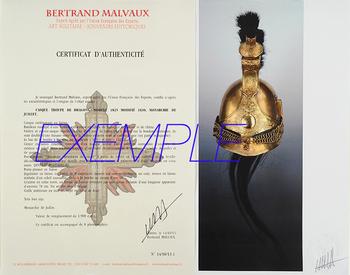
Next update Friday, december 26 at 13:30 PM
FOR ALL PURCHASES, PAYMENT IN MULTIPLE CHECKS POSSIBLE
bertrand.malvaux@wanadoo.fr 06 07 75 74 63
SHIPPING COSTS
Shipping costs are calculated only once per order for one or more items, all shipments are sent via registered mail, as this is the only way to have proof of dispatch and receipt.
For parcels whose value cannot be insured by the Post, shipments are entrusted to DHL or Fedex with real value insured, the service is of high quality but the cost is higher.
RETURN POLICY
Items can be returned within 8 days of receipt. They must be returned by registered mail at the sender's expense, in their original packaging, and in their original condition.
AUTHENTICITY
The selection of items offered on this site allows me to guarantee the authenticity of each piece described here, all items offered are guaranteed to be period and authentic, unless otherwise noted or restricted in the description.
An authenticity certificate of the item including the description published on the site, the period, the sale price, accompanied by one or more color photographs is automatically provided for any item priced over 130 euros. Below this price, each certificate is charged 5 euros.
Only items sold by me are subject to an authenticity certificate, I do not provide any expert reports for items sold by third parties (colleagues or collectors).
FOR ALL PURCHASES, PAYMENT IN MULTIPLE CHECKS POSSIBLE
bertrand.malvaux@wanadoo.fr 06 07 75 74 63
An authenticity certificate of the item including the description published on the site, the period, the sale price, accompanied by one or more color photographs is automatically provided for any item priced over 130 euros. Below this price, each certificate is charged 5 euros.
Only items sold by me are subject to an authenticity certificate, I do not provide any expert reports for items sold by third parties (colleagues or collectors).
